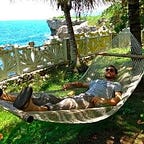OSM Marks the Spot
Haitians use a crowdsourced map to chart their own country, and its development
In 2004, Steve Coast started biking around London carrying a backpack with a GPS unit in it. Since 1791, the Ordnance Survey had been providing the UK government with excellent maps of the island country, but the data wasn’t freely available and was subject to a lot of license restrictions. Coast decided that he would map the world with open data, starting by cycling the street he lived on.
Nine years later, Haitians are riding motorcycles with handlebar-mounted GPS units to map their Caribbean island country as part of the same effort. Coast’s vision became OpenStreetMap, a crowdsourced project to produce an open-data map of the world that today has more than one million registered users. Foursquare, Apple, the U.S. National Parks Service, and craigslist all use OpenStreetMap (OSM) data for various purposes.
In the month following the January 2010 earthquake in Haiti, 600 volunteers from around the globe helped put Port-au-Prince on the map, literally. There had been no detailed and accurate digital map of the city. The Google Maps’ rendering of Haiti still lacks detail – national highways sometimes disappear into thin air – and its mapping of the capital’s side streets is riddled with errors. OSM contributors used satellite imagery from Yahoo! and out-of-copyright maps of Haiti to chart the metropolitan area, and search and rescue teams and humanitarian organizations relied on it for emergency and relief response.
Three years later, Haitians are working with the Humanitarian OpenStreetMap Team (HOT) to map the rest of the country. Samuel Alce served as adjunct coordinator of a spring 2012 project funded by USAID’s Office of Transition Initiatives (OTI) that mapped Saint-Marc, a coastal town about two hours north of the capital. In addition to populating the town’s map with government buildings and business locations, “It was a project to help 30 people learn how to do mapping,” he says. Now, Alce and others with HOT are working on a second USAID-funded venture, to fill in the country’s so-called Northern Development Corridor and train 60 young mappers in the process.
As a side project, Alce used OSM to create an online map of stations and routes used by tap-taps, the vibrantly-painted trucks and minibuses that ferry Haitians around the country. But less than 10 percent of Haitians use the internet, and map-literacy is low in a place where half the population can’t read and most people get directions from the mouths of friends or family.
“I’ve seen dispatchers of large NGOs and international organizations,” says Jaakko Helleranta, “who don’t know how to read a map.” Helleranta is senior coordinator of HOT and a self-proclaimed “map geek” who has lived in Haiti for the past three years while also consulting on a variety of development projects. The Finn says that training local mappers is just as important as improving the OSM map of Haiti itself.
In Haiti, much of HOT’s work with mappers has been in disadvantaged communities – the Cité Soleil shantytown was one of the first areas they focused on in Port-au-Prince. “I think it’s just mind-blowing and completely amazing, if not miraculous,” Helleranta says, “to see that HOT has been able to get a group of people, given the reality of their background, to actually create useful geo-information.” Mapping techniques are “challenging to explain to people who haven’t gotten a very good basic education,” he says, let alone people who have no experience with maps.
Alce was in Washington, D.C. last year for a crisis mapping conference. “I needed to find a place to eat,” he says, “and I looked on a map. I needed to find a place to buy a saxophone reed. I looked on a map. I knew how to read a map because of OSM.” That type of lasting change is what the projects’ funders hope to see.
Jessica Bryant, program advisor at USAID’s Office of Transition Initiatives, writes in an email that the Haiti mapping projects combine novel technology with “some basic, traditional development principles: projects work better when information and agency are in the hands of local community members, they are more successful when participants can see tangible results from their work, and ownership is key.” The project to map Saint-Marc ended more than a year ago, but it spawned a local group of mappers who still work together on mapping projects and to inform communities about OSM. “The areas where they have worked have become the best mapped cities in Haiti,” Bryant writes.
The goal of the current project to map Haiti’s North, she says, is to “enable communities to benefit as fully as possible from the investment headed their way.” The U.S. Government-backed Caracol Industrial Park opened last October and is the area’s, and country’s, largest post-earthquake investment. Henri Christophe University stands a few miles down the road in Limonade, a $30 million post-quake gift from the neighboring Dominican Republic. Recent mining exploration of potentially $20 billion in precious metals is concentrated in the northern region of the country. USAID and the Inter-American Development Bank have also committed tens of millions of dollars to four- to five-year agricultural projects in the region.
“With OSM,” Alce says, “we’re putting everything on the map in the North. You can look at the map and see we’ve got all this infrastructure being developed, commerce being developed, a university”
“For the North to really develop,” he says, “everything needs to be mapped.”
